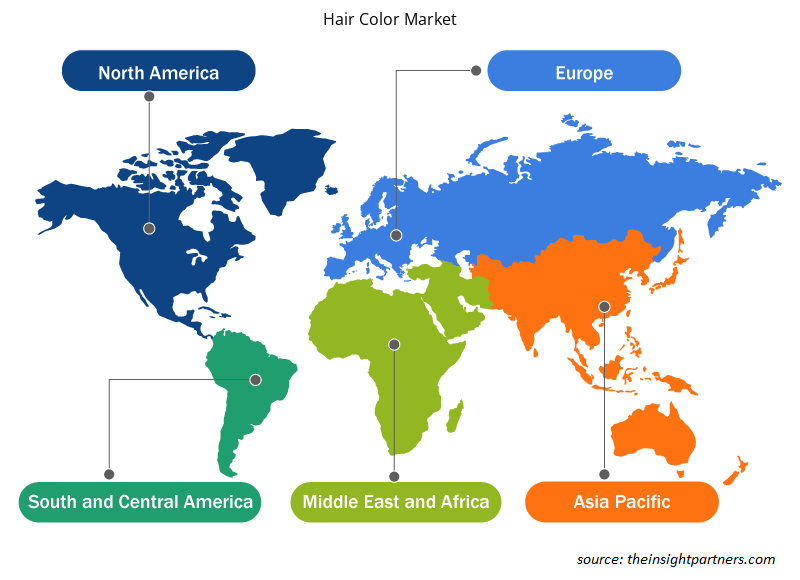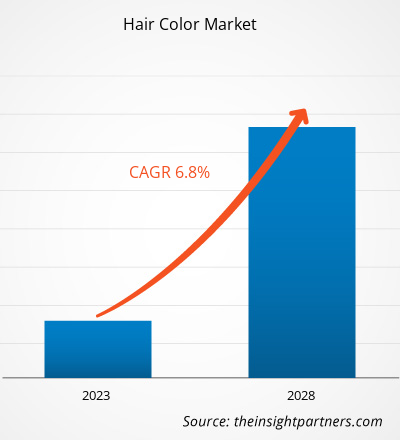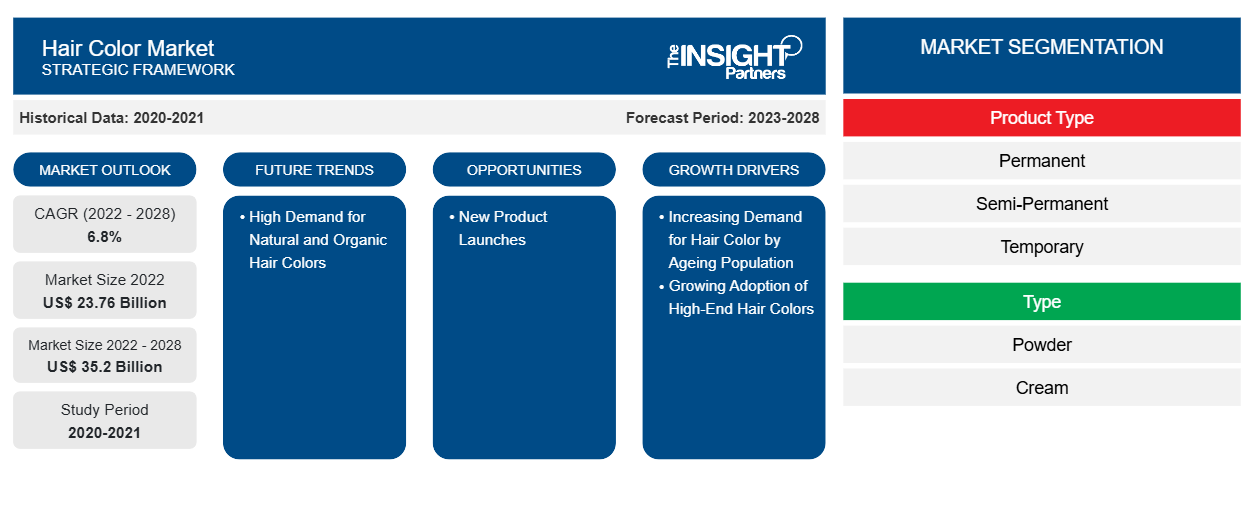[Forschungsbericht] Der Markt für Haarfarben soll von 23.762,28 Millionen US-Dollar im Jahr 2022 auf 35.201,69 Millionen US-Dollar im Jahr 2028 wachsen; von 2022 bis 2028 wird mit einer durchschnittlichen jährlichen Wachstumsrate von 6,8 % gerechnet.
Der Bericht beleuchtet die wichtigsten Markttreiber und prominenten Akteure sowie deren Entwicklungen auf dem Markt.
Markteinblicke und Analystenansichten:
Haarfarben sind Haarfärbemittel, die entweder zum Abdecken grauer Haare oder zum Ändern der natürlichen Haarfarbe aufgetragen werden. Es gibt grundsätzlich 3 Arten von Haarfarben: permanent, semi-permanent und temporär. Permanente Haarfarben verändern die natürliche Haarfarbe dauerhaft und erzielen in der Regel die besten Ergebnisse. Haarfarben sind in verschiedenen Farbtönen wie Schwarz, Braun und Burgunder erhältlich. Verbraucher legen großen Wert auf ihr Aussehen, was zu einer erheblichen Nachfrage nach Körperpflegeprodukten führt. Dieser Faktor treibt den Haarfarbenmarkt an . Darüber hinaus ist die zunehmende Alterung der Bevölkerung auch einer der Hauptfaktoren, die die Nachfrage nach Haarfarben und -färbemitteln antreiben.
Wachstumstreiber und Herausforderungen:
Die steigende Nachfrage der alternden Bevölkerung nach Haarfarben treibt das Wachstum des Haarfarbenmarktes an. Laut dem World Population Ageing Review von 2019 gibt es weltweit mehr als 703 Millionen Menschen im Alter von 65 Jahren oder älter. Die Weltbevölkerung altert aufgrund sinkender Geburtenraten und steigender Lebenserwartung schnell. Die alternde Bevölkerung verwendet häufig Haarfarben, um ihre grauen Haare abzudecken. Dieser Faktor treibt die Nachfrage nach Haarfarben erheblich an. Darüber hinaus kommt es aufgrund von Lebensstiländerungen und Nährstoffmängeln immer häufiger zu vorzeitigem Ergrauen. Menschen erleben vorzeitiges Ergrauen der Haare aufgrund von täglichem Stress, schlechten Ernährungsgewohnheiten, Rauchen und bestimmten Erkrankungen. Dieser Faktor dürfte auch die Nachfrage nach Haarfarben steigern und das Wachstum des Haarfarbenmarktes vorantreiben.
Passen Sie diesen Bericht Ihren Anforderungen an
Sie erhalten kostenlose Anpassungen an jedem Bericht, einschließlich Teilen dieses Berichts oder einer Analyse auf Länderebene, eines Excel-Datenpakets sowie tolle Angebote und Rabatte für Start-ups und Universitäten.
-
Holen Sie sich die wichtigsten Markttrends aus diesem Bericht.Dieses KOSTENLOSE Beispiel umfasst eine Datenanalyse von Markttrends bis hin zu Schätzungen und Prognosen.
Berichtssegmentierung und -umfang:
Der „globale Markt für Haarfarben“ ist nach Produkttyp, Art, Vertriebskanal und Geografie segmentiert.Basierend auf dem Produkttyp ist der Markt für Haarfarben in permanente, semipermanente und temporäre Farben unterteilt.Basierend auf dem Typ ist der Haarfarbenmarkt in Puder, Creme und andere unterteilt. Basierend auf den Vertriebskanälen ist der Haarfarbenmarkt in Supermärkte und Hypermärkte, Fachgeschäfte, Online-Einzelhandel und andere unterteilt. Der Haarfarbenmarkt ist geografisch in Nordamerika (USA, Kanada und Mexiko), Europa (Deutschland, Frankreich, Italien, Großbritannien, Russland und Rest von Europa), Asien-Pazifik (Australien, China, Japan, Indien, Südkorea und Rest von Asien-Pazifik), Naher Osten und Afrika (Südafrika, Saudi-Arabien, Vereinigte Arabische Emirate und Rest von Nahem Osten und Afrika) und Süd- und Mittelamerika (Brasilien, Argentinien und Rest von Süd- und Mittelamerika) unterteilt.UAE, and Rest of Middle East & Africa), and South & Central America (Brazil, Argentina, and Rest of South & Central America)
Segmentanalyse: Analysis:
Basierend auf den Vertriebskanälen ist der Markt für Haarfarben in Supermärkte und Hypermärkte, Fachgeschäfte, Online-Einzelhandel und andere unterteilt. Das Segment Supermärkte und Hypermärkte hält einen erheblichen Anteil am Markt für Haarfarben, und das Segment Online-Einzelhandel dürfte im Prognosezeitraum ein erhebliches Wachstum verzeichnen. Supermärkte und Hypermärkte sind große Einzelhandelsgeschäfte, die eine Vielzahl von Produkten lokaler und Premiummarken zu erschwinglichen Preisen führen. Darüber hinaus verfügen diese Geschäfte über qualifiziertes Personal, das dabei hilft, Produkte entsprechend den Kundenanforderungen zu finden. Darüber hinaus haben diese Geschäfte separate Abteilungen für Kosmetika und Körperpflegeprodukte, die den Kunden ein bequemes und problemloses Einkaufen ermöglichen. Diese Faktoren treiben den Verkauf von Haarfarbenprodukten über Supermärkte und Hypermärkte voran.
Der Markt für Haarfarben ist nach Typ in Puder, Creme und andere unterteilt. Im Jahr 2022 hatte das Pudersegment den größten Marktanteil. Viele Verbraucher bevorzugen Haarfarben auf Cremebasis, da sie sich leicht auftragen lassen. Darüber hinaus enthalten sie feuchtigkeitsspendende Inhaltsstoffe, die das Haar weich machen und ihm Glanz verleihen. Diese Faktoren treiben das Segmentwachstum maßgeblich voran.
Regionale Analyse:
Geografisch ist der Markt für Haarfarben in fünf Schlüsselregionen unterteilt: Nordamerika, Europa, Asien-Pazifik, Süd- und Mittelamerika sowie Naher Osten und Afrika. Der globale Markt für Haarfarben wurde vom Asien-Pazifik-Raum dominiert, der im Jahr 2022 7.741,75 Millionen US-Dollar ausmachte. Nordamerika ist ein zweitgrößter Marktteilnehmer mit einem Anteil von über 26 % am Weltmarkt. Die Kosmetikindustrie im Asien-Pazifik-Raum wächst, mit steigender Nachfrage nach Premiumprodukten und einer Zunahme der Zahl berufstätiger Frauen. Darüber hinaus trägt die alternde Bevölkerung in der Region weiter zum Wachstum des Haarfarbenmarktes bei. Laut der Weltgesundheitsorganisation (WHO) hat China eine der am schnellsten wachsenden alternden Bevölkerungen der Welt. Aufgrund der höheren Lebenserwartung und sinkender Geburtenraten wird der Anteil der über 60-Jährigen in China bis 2040 voraussichtlich 28 % erreichen. Daher wird erwartet, dass die steigende Nachfrage nach Körperpflege in Verbindung mit der steigenden Zahl berufstätiger Frauen und der alternden Bevölkerung das Wachstum des Haarfarbenmarktes im gesamten Asien-Pazifik-Raum vorantreiben wird.
Branchenentwicklungen und zukünftige Chancen:
Nachfolgend sind verschiedene Initiativen der wichtigsten Akteure auf dem Haarfarbenmarkt aufgeführt:
- Im Jahr 2022 brachte The Arctic Fox eine neue Haarfarbe auf den Markt, Space Cowgirl, eine leuchtende Farbe mit Grün- oder Pfirsichtönen. Dieses neue Produkt kann in einem vom Unternehmen angegebenen Verhältnis mit Aquamarin, Poseidon, Neon Moon, Frose oder Periwinkle gemischt werden, um dem Haar verschiedene Farbtöne zu verleihen.
- Im Jahr 2022 gab PZ Cussons die Übernahme von Childs Farm bekannt, der marktführenden Marke für Baby- und Kinderpflegeprodukte in Großbritannien mit einem Marktanteil von 15 % in dieser Kategorie. Die Produktlinien umfassen Bade- und Duschprodukte, Hautpflege und Haarpflege. Sie basieren alle auf einem natürlichen Ansatz und sind für empfindliche Haut geeignet.
- Im Jahr 2022 kündigte L'Oréal SA die Einführung von Colorsonic für Verbraucher und Coloright-Technologien für Stylisten an. Das Unternehmen arbeitete mit 400 Kunden zusammen, um Colorsonic-Produkte zu entwickeln. Das Produkt enthält eine Farbkartusche (40 Farben), einen Mixer (kombiniert die Farbe und entwickelt sie für den Kunden) und einen Kammapplikator. Darüber hinaus konzentriert sich die Coloright-Technologie darauf, Konsistenz zu schaffen und Dateneinblicke in den Färbeprozess zu liefern.
Regionale Einblicke in den Haarfarbenmarkt
Die regionalen Trends und Faktoren, die den Haarfarbenmarkt im Prognosezeitraum beeinflussen, wurden von den Analysten von Insight Partners ausführlich erläutert. In diesem Abschnitt werden auch die Marktsegmente und die Geografie des Haarfarbenmarkts in Nordamerika, Europa, im asiatisch-pazifischen Raum, im Nahen Osten und Afrika sowie in Süd- und Mittelamerika erörtert.

- Holen Sie sich regionale Daten zum Haarfarbenmarkt
Umfang des Marktberichts über Haarfarben
| Berichtsattribut | Details |
|---|---|
| Marktgröße im Jahr 2022 | 23,76 Milliarden US-Dollar |
| Marktgröße bis 2028 | 35,2 Milliarden US-Dollar |
| Globale CAGR (2022 - 2028) | 6,8 % |
| Historische Daten | 2020-2021 |
| Prognosezeitraum | 2023–2028 |
| Abgedeckte Segmente |
Nach Produkttyp
|
| Abgedeckte Regionen und Länder |
Nordamerika
|
| Marktführer und wichtige Unternehmensprofile |
|
Dichte der Marktteilnehmer für Haarfarben: Die Auswirkungen auf die Geschäftsdynamik verstehen
Der Markt für Haarfarben wächst rasant, angetrieben durch die steigende Nachfrage der Endverbraucher aufgrund von Faktoren wie sich entwickelnden Verbraucherpräferenzen, technologischen Fortschritten und einem größeren Bewusstsein für die Vorteile des Produkts. Mit steigender Nachfrage erweitern Unternehmen ihr Angebot, entwickeln Innovationen, um die Bedürfnisse der Verbraucher zu erfüllen, und nutzen neue Trends, was das Marktwachstum weiter ankurbelt.
Die Marktteilnehmerdichte bezieht sich auf die Verteilung der Firmen oder Unternehmen, die in einem bestimmten Markt oder einer bestimmten Branche tätig sind. Sie gibt an, wie viele Wettbewerber (Marktteilnehmer) in einem bestimmten Marktraum im Verhältnis zu seiner Größe oder seinem gesamten Marktwert präsent sind.
Die wichtigsten auf dem Haarfarbenmarkt tätigen Unternehmen sind:
- Polarfuchs
- Coty Inc.
- Henkel AG & Co. KGaA
- Kao Singapore Pte Ltd.
- M
Haftungsausschluss : Die oben aufgeführten Unternehmen sind nicht in einer bestimmten Reihenfolge aufgeführt.

- Überblick über die wichtigsten Akteure auf dem Haarfarbenmarkt
Auswirkungen von Covid-19:
Die COVID-19-Pandemie betraf fast alle Branchen in verschiedenen Ländern. Lockdowns, Reisebeschränkungen und Betriebsschließungen in Nordamerika, Europa, Asien-Pazifik (APAC), Süd- und Mittelamerika (SAM) sowie dem Nahen Osten und Afrika (MEA) behinderten das Wachstum mehrerer Branchen, darunter auch der Konsumgüterindustrie. Die Schließung von Produktionseinheiten störte globale Lieferketten, Fertigungsaktivitäten, Lieferpläne sowie den Verkauf lebensnotwendiger und nicht lebensnotwendiger Produkte. Verschiedene Unternehmen erlebten im Jahr 2020 Verzögerungen bei Produktlieferungen und einen Einbruch der Verkäufe ihrer Produkte. Aufgrund der pandemiebedingten Wirtschaftsrezession wurden die Verbraucher bei ihren Kaufentscheidungen vorsichtiger und wählerischer. Die Pandemie führte jedoch zur vorübergehenden Schließung von Schönheitssalons, was viele Verbraucher dazu zwang, sich zu Hause selbst die Haare zu färben. Dies erhöhte die Nachfrage nach Haarfarben im gesamten Wohnbereich. Da die Menschen außerdem zu Hause bleiben mussten, widmeten sie sich verschiedenen Heimwerkeraktivitäten, was sich positiv auf den Verkauf von Haarfarben auswirkte. Da Supermärkte, Verbrauchermärkte, Einkaufszentren und Geschäfte, die nicht lebensnotwendige Produkte verkaufen, in der Anfangsphase der Pandemie jedoch geschlossen blieben, waren die Menschen auf E-Commerce- Einzelhandelskanäle wie Amazon.com, eBay und SnapDeal angewiesen.
Bis Ende 2021 waren viele Länder vollständig geimpft und die Regierungen kündigten Lockerungen bestimmter Vorschriften an, darunter Ausgangssperren und Reiseverbote. Verschiedene Geschäfte, darunter Supermärkte, Kaufhäuser, Einkaufszentren und Tante-Emma-Läden, durften wieder öffnen, was auch den Verkauf von Haarfärbeprodukten steigerte. All diese Faktoren beeinflussten das Wachstum des Haarfärbemarktes positiv.
Wettbewerbslandschaft und Schlüsselunternehmen:
Zu den prominenten Akteuren auf dem globalen Haarfarbenmarkt gehörenArctic Fox; Coty Inc.; Henkel AG und Co. KGAA; und Kao Singapore Pte. Ltd.; Revlon, Inc.; Hygienic Research Institute Pvt. Ltd; L'oréal SA; Wella Operations US LLC; Unilever PLC; und PZ Cussons Beauty LLP; um nur einige zu nennen. Diese Unternehmen sind stark in Fusions- und Übernahmeaktivitäten involviert, um ihre geografische Präsenz auszuweiten und ihre Expertise zu verbessern. Darüber hinaus wenden diese Unternehmen innovative Marketingstrategien wie digitales Marketing, Social-Media-Marketing und innovative Werbekampagnen an, um ihr Markenimage in den Köpfen potenzieller Verbraucher zu stärken.
- Historische Analyse (2 Jahre), Basisjahr, Prognose (7 Jahre) mit CAGR
- PEST- und SWOT-Analyse
- Marktgröße Wert/Volumen – Global, Regional, Land
- Branchen- und Wettbewerbslandschaft
- Excel-Datensatz
Aktuelle Berichte
Verwandte Berichte
Erfahrungsberichte
Grund zum Kauf
- Fundierte Entscheidungsfindung
- Marktdynamik verstehen
- Wettbewerbsanalyse
- Kundeneinblicke
- Marktprognosen
- Risikominimierung
- Strategische Planung
- Investitionsbegründung
- Identifizierung neuer Märkte
- Verbesserung von Marketingstrategien
- Steigerung der Betriebseffizienz
- Anpassung an regulatorische Trends























 Kostenlose Probe anfordern für - Haarfarbenmarkt
Kostenlose Probe anfordern für - Haarfarbenmarkt